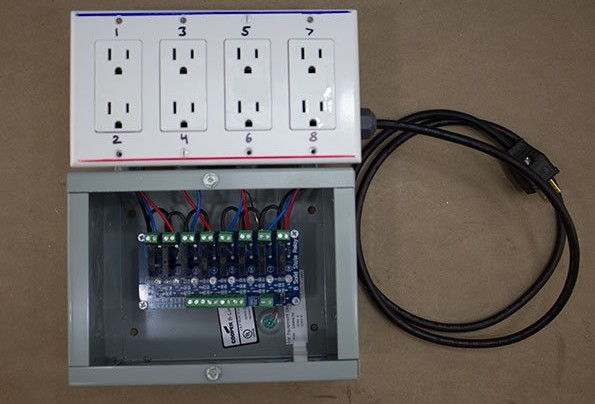 Photos: Christopher Alden
Photos: Christopher Alden
In building our latest project, The Great Houdini Escape Room, located in the Palace of Fine Arts in San Francisco, we tackled many Maker challenges. Everything in the room was built from “scratch.” The room uses over 5,000 feet of wire and is operated on over 5,000 lines of code running on 8 Arduino Megas. Those Megas connect to hundreds of inputs and outputs, including nearly 50 objects (such as lights) that are high voltage or, at least, require more voltage than the 5V that an Arduino can pump out.
Low voltage and high voltage environments are very different, and it can be challenging to build a complex system that requires both environments to work together seamlessly. And, of course, low-voltage systems are safe (think batteries) while high-voltage systems are dangerous (think wall sockets).
Since current can’t flow directly between low- and high-voltage networks, the interaction between these two systems is often managed via a relay. Data from an Arduino triggers a relay, which in turn switches a high-voltage connection on or off. Think of it as a light switch.
Wiring a relay, however, can be tricky. One side is low voltage and the other high. There needs to be a safe area for these relays to operate, away from tinkering hands. Arduino is fun because wires can be plugged in and moved at will — all without risk of electrocution. But once you bring high voltage into the mix, that easy plug-and-play ability goes away.
Wiring a relay is not a major undertaking, but we had to wire 50 of them. More significantly, however, we wanted to have the same flexibility with our higher-voltage elements as with our Arduino powered elements — it should be just as easy to swap out a lightbulb connection as an LED.
So we created the Plug & Play Arduino Relay. In brief, we put the relays in a junction box and mounted an electrical box on top with regular wall outlets inside. By wiring these outlets to the relays we created a plug-and-play device that works on both ends. Data wires come out of the box and can be safely connected to an Arduino. And any electrical device with a plug on the end — be it a light, a fan, or a blender — can be plugged and unplugged, as easily as you would with a simple power strip.
We built several of these reusable devices — there are eight used in the Great Houdini Escape Room — and now, any time we need to add, change, or remove a high-voltage device, there is no tricky high-voltage wiring needed – just plug and play.
WARNING:
This project involves wiring for high-voltage applications. Use caution whenever dealing with high-voltage wiring, including following directions carefully and general safety practices. Safe assembly and operation of this project is the user’s responsibility. Do not make changes to the system while the device is plugged in.
Editor’s note: Alden’s Great Houdini Escape Room was profiled recently by Make: See our coverage here. Alden is interested in hearing more ideas for how he can improve on the design, either of the relay or upcoming escape rooms themselves. Visit him on the web at palace-games.com.




